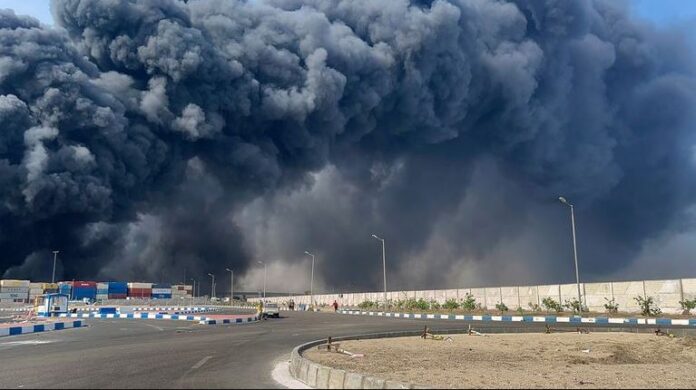Bandar Abbas, April 27, 2025 – A devastating explosion at Shahid Rajaee port, Iran’s largest commercial hub near Bandar Abbas, on April 26 claimed at least 18 lives and injured over 800, with hazardous chemical storage and negligence emerging as the primary causes. The blast, which sent shockwaves through the region, shattered windows kilometers away and unleashed a toxic plume of reddish-black smoke, prompting a public health emergency and halting port operations.
Improper Chemical Storage Ignites Catastrophe
Iranian authorities pinpointed poorly stored chemicals as the explosion’s origin. Hossein Zafari, a spokesperson for Iran’s crisis management body, told ILNA news agency that containers holding volatile substances were mishandled, despite prior warnings about unsafe storage practices. “The chemicals inside the containers were the cause,” Zafari stated, underscoring systemic failures in safety protocols at the port, which handles 80 million tons of goods annually, including oil and container shipments.
25 people killed in Iranian port explosion
Sodium Perchlorate Shipment Raises Alarms
Security firm Ambrey linked the blast to a March shipment of sodium perchlorate, a chemical used in missile fuel, reportedly received from China to replenish Iran’s missile stocks. Improper handling of this highly reactive compound may have sparked the fire, with social media footage of reddish smoke suggesting a chemical reaction akin to the 2020 Beirut port disaster. The port’s strategic role makes such shipments sensitive, amplifying concerns about oversight.
Also Read: Pakistan Eyes $1.4B Boost in Currency Swap Line with China for Economic Stability
Negligence Echoes Past Disasters
State media highlighted negligence in managing flammable materials, drawing parallels to Beirut’s ammonium nitrate explosion. Known risks at Shahid Rajaee, previously targeted by a 2020 cyberattack attributed to Israel, were not addressed, allowing hazardous conditions to persist. This failure has sparked outrage, with citizens demanding accountability.
🚨 #Breaking: This video was retrieved from the phone of a deceased worker at Rajaee Port in #BandarAbbas, #Iran. It captures the moments following an initial explosion that blew a hole in one of the containers, sparking a fire that eventually led to the massive, destructive… pic.twitter.com/QDY5BwHnBJ
— Babak Taghvaee – The Crisis Watch (@BabakTaghvaee1) April 26, 2025
Sabotage Ruled Out Amid Tensions
Despite the explosion’s timing during nuclear talks in Oman, Foreign Minister Abbas Araghchi dismissed sabotage, though security services remain vigilant. President Masoud Pezeshkian ordered a comprehensive investigation, dispatching Interior Minister Eskandar Momeni to oversee efforts. “We must ensure this never happens again,” Pezeshkian posted on X, expressing condolences.
The blast collapsed buildings, scattered debris, and released toxic pollutants, forcing school and office closures in Bandar Abbas. As firefighting efforts continue, Iran grapples with the preventable tragedy, with blood donation drives underscoring national solidarity. The investigation’s findings will be critical to preventing future disasters at this vital economic lifeline.



